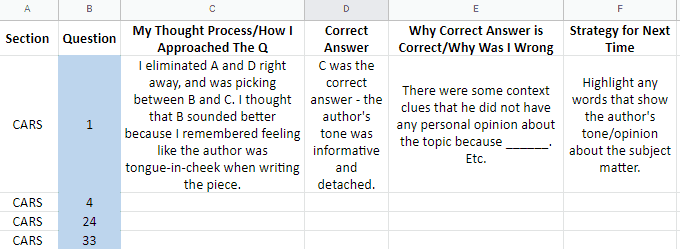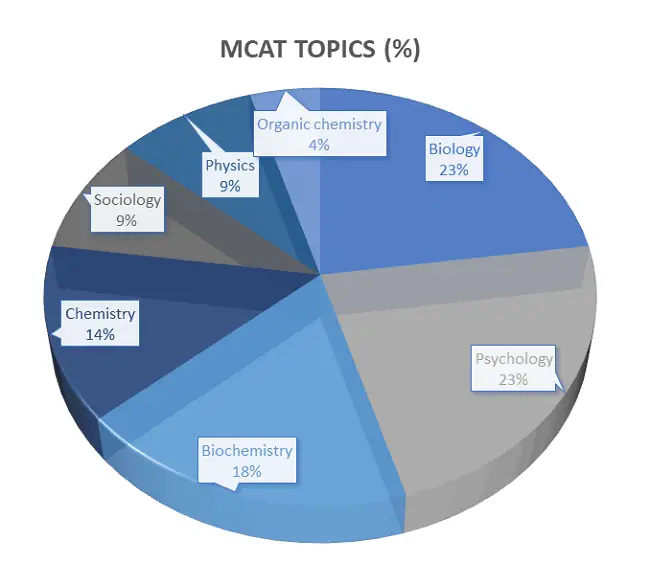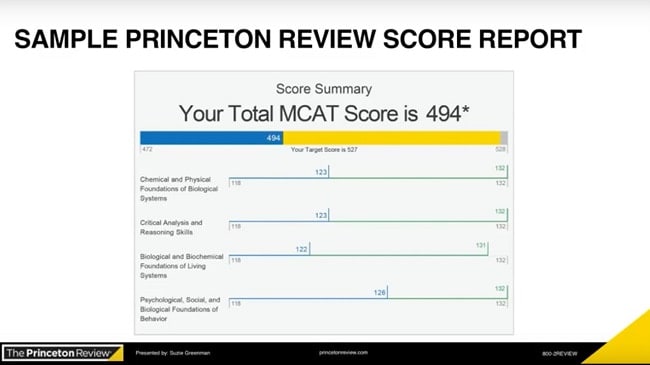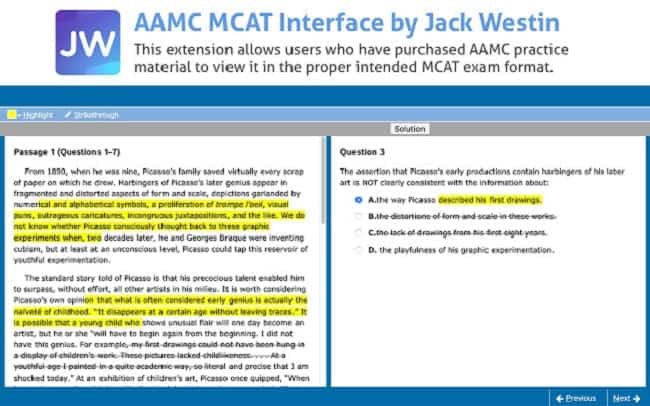
Boosting your MCAT score demands both persistence and focus.
Even with limited time, you can elevate your score significantly. This guide will lay out 26 key MCAT strategies to help you maximize your results in a crunch. Think of this as a quick buffet of test-taking tactics. Pick the best ones and dive in — the clock is ticking!

Improving your MCAT score within only one week
If you have only one week, my number one MCAT study tip is to complete and review as many practice exams as you can. Grab the spreadsheet in Google Sheets below, and put your results in there. Focus primarily on the questions you’ve missed after each session and write notes next to them. Once you have enough data, you’ll see a pattern (for example, you may have issues with passage-based questions). Exploit this insight to your advantage, so you’ll know what to look for on the actual MCAT. In summary: complete, up to 3 practice exams (preferably from AAMC), take breaks in between, analyze your results with a spreadsheet, and then focus on areas where you can improve the most. Also, make sure you regularly review your MCAT content summary sheet.

Improving your MCAT score within two weeks
The clock is ticking. If you only have two weeks, set up a detailed schedule, so you know exactly what you need to get done within the time frame. You should take up to three full-length MCAT exams (with two or three days in between). But do not take a practice exam right before the real MCAT. Save some brainpower to increase your performance. Avoid content review activities because that’s of no help at this point. Instead, focus on analyzing the results you’ve got from completing the full-length tests. It should be a cycle of testing, reviewing, and drilling. Continue like this and cover your weaknesses by focusing on the highest potential yield topics. Another thing that works great for many students is learning how to find answers right in the passages. This is a huge score booster. Then one day before your test, make sure to relax and try to get your mind off the MCAT. It’s great to unplug, walk around in nature, and meditate a bit. This will allow you to hit the test center with the right state of mind.

Improving your MCAT score within one month
If you have one a month to study for the MCAT, there’s plenty of time to play with. There are cases of students who increased their scores by 15-20 points within a single month.
However, this kind of feat is not easy to pull off:
- Complete up to five full-length practice tests (make sure you take regular breaks to avoid burnout)
- Analyze your results with a spreadsheet (identify your weaknesses and highest yield topics)
- Learn how to analyze passages, questions, and answer choices faster.
- Work on your timing (learn to move on if you can’t answer a question within 1,5 or 2 minutes)
- You can also use a flashcard mobile app like Anki, UWorld, or Magoosh to boost your psychology and sociology scores.
- Work on physical and mental stamina to be alert for 7,5 hours during the test. Getting mentally exhausted is one of the primary reasons why people flunk the test.
Related content: The Best MCAT Prep Courses To Take
The best ways to improve your MCAT score:
1. Make the most of your MCAT practice exams

Analyzing your answers with a Google Spreadsheet is one of the best ways to improve your results.
Analyzing your practice exams properly will have a big impact on your final score. Instead of just checking the answers and moving on, do the following: think about your performance, timing, stress level, favorite questions, and mental endurance. Also, check your answers on the second day to approach the test with fresh eyes. When going through your answers, put the wrong ones in a Google Spreadsheet. Make notes next to each wrong answer and think about what you need to learn to get it next time. Make a deal with yourself that you will never get this type of problem wrong again. This will help you discover your weaknesses and spot answer patterns like nothing else.
2. Learn how to identify the correct answer faster
When dealing with a particularly lengthy and convoluted question, you will often get stuck between two answers. Both of them are correct statements, but only one of them answers the actual question. In other words, your choice absolutely must relate to the question at hand. One of the best hacks is to read the last sentence of the question first and then immediately look over all possible answers. MCAT designers like to put a lot of fluff in a passage to confuse you. But often, you’ll realize that in essence, the question is straightforward. Always look for the gist of it.
3. Eliminate the wrong answers immediately
Give yourself a few seconds to skim through each question and read the last sentence (like in tip #2). Then look at the possible answers. You will see that often you can eliminate one or two wrong choice options. This will often cut down your answer time dramatically, which brings us to the next point. Related content: 10 Best MCAT Practice Tests
4. Use the top MCAT timing hacks
a) Always complete your practice tests with a timer.
For this, I recommend an inexpensive online MCAT course like Magoosh. It costs only $279, and it will give you access to over 700 timed practice questions to complete in an online dashboard or mobile app.

Practicing with a timer is always a good idea.
b) Upon entering the test center, instructors will briefly outline the test’s dos and don’ts.
You’ll have a noticeboard in front of you, so use this time to write down the major MCAT-related equations, diagrams, and mathematical values. This memory dump will free up a lot of mental energy later on and allow you to save a ton of time.

“Brain dump” important equations to free up your working memory.
c) Learn how to outline questions.
While going through questions at a quick pace is great, sometimes it can lead to careless mistakes. A good strategy here is to outline each section of a passage, so you fully understand it. For example:
- P1 (paragraph 1): Enzymes cat. (catalyze) runs
- P2 (paragraph 2): Lactase = lactose breakdown (breakdown)
Using this approach will help you keep your eye on the ball and avoid distractions.
d) Learn how to bail on a slow question.
If it’s taking you more than 1,5 – 2 minutes to answer the question, it’s time to move. This is one of the best MCAT study tips I can share with you. You might be tempted to spend more time on it, but remember that the goal is to maximize the final score. So take note and move on to the next one. You can always come back to these problematic passages at the end when you still have a few minutes left. You will often realize that your subconscious mind found the answer for you when you come back to it.
Extra tip:
Remember to answer every single question because there is no penalty for giving a wrong answer (25% chance is always better than 0%).
Related content: 15 Best MCAT Prep Books & Study Materials (With Links)
5. Focus on high-yield MCAT subjects first:
- Biology – 25%
- Psychology – 25%
- Biochemistry – 20%
- Chemistry – 15%
- Sociology -> 10%
- Physics -< 10%
- Organic chemistry -> 5%
By looking at the numbers, you see that biology, chemistry, and psychology take up 75% to 80% of the whole exam. Keep that in mind during your prep and focus mostly on these high-yield topics. I’m not telling you to skip physics and sociology, but make sure you have a bio-chem-psych covered first.

6. Use your mouse cursor as a pointer while reading the questions
Using a pointer like a mouse cursor, while reading will increase your speed and comprehension. It will also keep distractions at bay and boost your focus. But make sure to check if this strategy works for you. For some students, using a pointer and highlighting a lot is a distraction that lowers their final score.
7. Identify your baseline performance on each MCAT section
That’s where completing as many practice tests as possible comes in handy. With MCAT courses like the ones from the Princeton Review, completing 8 full-length practice tests is mandatory before attempting the real thing. And that’s for a good reason. Completing practice tests and analyzing the results will show you which sections you need to improve in. Some apps and courses will show you this info on a dashboard. But you can also put this information in your spreadsheet and track your results over time. Always focus on the highest potential yield sections first.

By completing online practice tests, you’ll exactly where you’re lagging.
8. Create a real test-taking environment and get used to it
MCAT test centers are dreary places that can look intimidating. You’ll be sitting in a cubicle and have only walls to stare at. The whole experience takes around 7,5 hours (content time – 6h 15 min, 7h 30 min ‘seated’ time). I suggest you re-create this setting in your library at least once before attempting the test.
The schedule goes like this:
- Tutorial – 10 mins
- Chemical and physical foundations of biological systems – 95 min
- Break – 10 mins
- CARS – 90 mins
- Mid-exam lunch break – 30 mins
- Biological and biochemical foundations of behavior – 95 mins
- Break – 10 mins
- Psychological, social, and biological foundations of behavior – 95 mins
- Void question (here you can make your test void if you feel you’ve flunked) – 5 mins
- Satisfaction survey – 5 mins
Grab one of the full tests and go through the whole thing with a timer, exactly according to the AAMC’s schedule.
9. Use noise-canceling headphones or not
When you arrive at the test center, you’ll see there are these (usually orange) headphones in each cubicle. These are for noise cancellation. Before the exam, think if you prefer to work in total silence or have some ambient noise. Many students say that going into total silence helps them to maximize their focus.
10. Manage your physiology during the MCAT (this one is crucial!)
To achieve a peak score, you need to be in peak physical and mental condition before (and especially during) the test.
Do these things to be at your best:
- Get at least 8 hours of sleep before the test day (cramming the night before the test is the worst idea ever).
- Focus on your breath for a couple of minutes and listen to ambient music with Alpha waves. This will help you relax and get into a calm and focused state of mind. Meditation has been linked to higher performance on a quiz-based test.
- Get your caffeine in small drips. As a pre-med student, you know that dosage is everything when it comes to drugs. If you don’t drink coffee regularly, don’t do it on your MCAT. It can give you feelings of anxiety and even heart palpitations. But if you do drink coffee, bring it in a small tumbler. It will keep the liquid warm, and you can keep drinking it during each break. That’s way better than gulping down the whole thing in a couple of minutes and facing inevitable jitters.
- Eat a light, brain-power-boosting meal for breakfast and during the lunch break. Avoid carbs as they’ll give you a sugar crash. Instead, go for green veggies and healthy fats to maintain mental focus for longer.
- Get some oxygen during each break. High levels of oxygen in the body are crucial for mental performance. During the breaks, take 2 or 3 minutes and practice deep breathing. It will calm you down and give you more energy when you come back for the next section.
11. Remember to relax and keep it steady during your prep sessions
Getting overworked and overwhelmed will lead to burnout. That’s why maintaining a healthy lifestyle is crucial to achieving a high score on the MCAT. Get enough sleep, take regular breaks between study sessions, avoid fast food and alcohol, and take regular exercise. These things will enable you to approach your prep in a more relaxed manner. Remember that it’s not about studying until your brain falls apart. It’s about consistent daily effort over 3 to 4 months that will lead to better results. It’s called the 100-day rule because that’s how much time you’ll need to get fully prepared. Spend the first 50% of the time on content review, and the other 50% on testing, timing, and honing skills described in this article.
12. Join an MCAT study group or take a prep course
Study groups are great, but you should know your personality before committing to one. If study groups worked for you in the past and you have a gregarious personality, then, by all means, go for it. It can give you a sense of progress and allow you to share insights and study materials with other students. But if you’re an introvert and like to study on your own, you can skip the study group and focus on studying in silence. Moreover, you may consider signing up for one of the MCAT prep courses. They will give you a more structured approach to studies and allow you to spend time with experienced instructors.
Related content: Top MCAT prep courses to take
13. Make the best of your MCAT noticeboard
Right before you begin the MCAT, you’ll get a noteboard booklet along with a fine point marker. The noteboard is 8” x 14”, spiral bound, and has nine single-sided pages. How to make the most of this noteboard: As soon as you get it, use it to write the most important formulas and equations you’ve memorized. This kind of brain dump will free up your working memory to tackle difficult questions. Other than that, use it to take notes, summarize questions, and make calculations.
Pro tip:
If you need extra writing material, you can raise your hand, and the test administrator will give you a new noteboard. Also, make sure that your marker has ink in it as soon as you get it. You’ll possibly save yourself some time and frustration.
14. Highlight key phrases when going through passages and questions
Here, opinions vary. Some students swear by highlighting (especially in the CARS section), while others say it doesn’t improve their scores. You have to test it out and see what works for you. First, you select the text and then press Alt + H. It might work if you mark only the most important parts of a passage. These highlights will make it easier for you to focus on and recognize patterns in certain types of questions. Also, when you’re under stress, you may forget a critical distinction in a passage. But with a highlight, you’ll have it right in front of you. Highlighting is a skill you need to work at to get better at. That’s why, when drilling before the test, you need a highlighter-enabled interface. Some materials from AAMC lack this feature, but you can fix the problem with the Highly Highlighter Chrome extension or with the AAMC MCAT Interface by Jack Westin. The highlighting feature is an important consideration if you plan to take an MCAT course like the one from Kaplan or Princeton Review.

With the right extension, you can highlight to your heart’s content.
15. Use of the top MCAT mobile study apps like Anki, UWorld, and Magoosh
There are three mobile study apps best for quick memorization of core MCAT concepts. Flashcards baby that’s what I’m talking about! Hit them when you ride a train or go to the loo.
Anki
Anki is a free app that uses the spaced repetition method to make the concepts you learn stick. Online you can find dozens of MCAT-related Anki decks. Some of them hold as many as 10,000 notes and hundreds of images. The free app also gives you awesome performance statistics. The app is available on both Android and iOS.
UWorld
UWorld produces a lot of test-prep apps, and they’re all great. This one holds over 1900+ MCAT practice questions. They come with detailed explanations and many of them contain colorful illustrations. The best thing about the app is that it’s completely free. Many students say it helped them score in the 90th+ percentile. The app is available on both Android and iOS.
Magoosh
As mentioned before, Magoosh offers a cool MCAT course, but they also have a neat app. You’ll get most of the functionality even with the free version. But you would need to upgrade to premium to get access to everything, including 12 months of access, 745+ questions (with explanations), a great interface, and 380+ video lessons. There’s also a 7-day free trial, so you can easily check if it’s something for you. The app is available on both Android and iOS.
16. Know what to do when you’re short on time
The first rule is to not spend more than two minutes on any single question (45 seconds per stand-alone question is great). If you can’t figure out the question, save it for later and move on. Then, at the end of each section, go back to these challenging questions, and give them a quick answer (you don’t lose points for wrong answers). Once the answers are marked, take the time to review each question in the section. This will ensure that you don’t make any random mistakes because of distraction or lack of focus. To save time for a final review, you need to have the right timing throughout the test. This is done through endless practice with full-length tests. After getting around eight of these done, you’ll have an internal clock and become a pacing master.
17. Watch out for MCAT “trap questions”
There are a couple of ways in which you can sidestep MCAT’s trap questions:
- a) Forget your background knowledge and cherished opinions. Instead, try to decipher the author’s argument. What exactly is the question?
- b) If you’re stuck between two close answers, go for the less extreme one. This will usually be the correct one.
- c) Don’t try to “talk yourself” into an answer. If you have to make excuses for an answer, it’s probably wrong.
- d) Identify and highlight a keyword in a question. For example, a word like “least” may change the meaning of the whole question.
For more information on that, you can listen to a podcast called “Dissecting MCAT Biology Discrete Trap Answers.”
18. Answer the question in your mind before looking at the answers
This is an old-school method that may boost your score significantly. Instead of looking at the answers immediately, first, try to answer in your mind. This will immediately point you in the right direction and help you eliminate wrong answers.
19. Know the most effective MCAT hacks
Did you know there are specific MCAT hacks you can apply?
Here is a couple:
- The total resistance is always less than the smallest resistor. This can help you get to a 50/50 position with tricky questions.
- Most o-chem reactions are a nucleophile attacking the electrophilic carbonyl carbon and displacing a leaving group.
- Electron configuration for chromium is [Ar] 4s1 3d5, not [Ar] 4s2 3d4 as you would expect.
- Piaget’s Developmental Stages: “Stupid Piaget Creates Fuss” (Sensorimotor, Preoperational, Concrete Operations, Formal Operations). You can find many more MCAT mnemonics here.
20. Get the most out of your study sessions (improve learning productivity)
I like talking about writing productivity, but you can improve your learning productivity too:
- a) Keep your regimen strong, and make a plan for what exactly you want to learn.
- b) Set a timer, study for 4-8 hours a day (depending on time availability), and keep stats about it. That’s super important.
- c) Take a 10-minute break each hour. Don’t count breaks and food as study time!
- d) Don’t give up, become distracted, and lose half of your day doing nothing.
- e) Keep your target score in front of your face, and be relentless about achieving it.
- f) Have a positive attitude towards the test.
- g) Record your old pre-requisite notes and listen to them like a podcast.
- h) If you can get a set of flashcards to help you prepare for the exam, it would be very helpful too.
21. Learn how to move on to the next question
Many prospective doctors fail on MCAT because they get stuck on one question for 8-12 minutes. Don’t let this be you. You need to learn how to let go and move on to the next question.
22. Use your test brakes in the most efficient way
Remember that the MCAT is much different than any other test you took in the past. With 7,5 hours, it’s a marathon, not a sprint. That’s why top-scoring students use their breaks to relax and improve their mental performance. You should do the same. You’ll have your first break after 95 minutes (chemical and physical foundations of biological systems). This break will give you 10 minutes of respite. Then, you’ll have a 30-minute lunch break after the CARS section. Lastly, you’ll get a 10-minute break after the “biological and biochemical foundations of behavior” section. Make sure to take all of these breaks, because, after 90 minutes or so of heavy mental effort, your brain will be drained of energy. During the break, you should get a lot of oxygen in your lungs by practicing deep breathing exercises. This will calm you down and give you extra stamina to conquer the next part of the test. Additionally, make sure to keep hydrated at all times, and only eat low-carb snacks during the break. High-sugar stuff like chocolate bars will give you a sudden rush of energy, but after a few minutes, you’ll crash and burn because of spiked insulin levels. You aim to keep the energy levels steady. Remember – a marathon, not a sprint.
23. Learn how to break up your MCAT study sessions
It’s great to spend the first half of your study time on content review, and the other one on drills. As the day of the exam starts to loom large, focus on full-length tests more than anything else. Also, each time you start a 1h study session, know exactly what you want to learn. Focus on high-yield topics first, and keep meticulous stats about your performance in each section. Your goal is to optimize your study efforts by raising the bar on each section. Optimize, definition: “modify to achieve maximum efficiency in storage capacity or time or cost.”
24. Identify the best opportunities for score improvement
Remember that if you want to score in the 85th+ percentile, all of the MCAT topics are “high-yield.” But some topics are most commonly tested, and you should master them first, especially when you’re running out of prep time.
These include:
- Amino acids, peptides, and proteins
- Emotion
- Transmission of genetic info to the protein
- Endocrine system
- Fluids
You can get a full list of these topics here.
25. Learn how to use the MCAT tools available during the test
Develop a clear understanding of all the tools you’ll have at your fingertips during the test. First of all, you’ll be able to use keyboard shortcuts. You don’t need to memorize them as they’ll be available on your screen during the test.
Here are a couple of examples of the keyboard commands you can use:
- Alt + N – takes you to the next question and Alt + P to the previous question.
- Alt + V – opens up the navigation window and Alt + C closes it.
- Alt + T – opens up the periodic table.
- When you select a piece of text with your mouse, use Alt + H to highlight it and Alt + S for strikethrough.
- Alt + F – flags a question for review.
- After the end of each section, you can type Alt + A to review all questions, Alt + I to review incomplete questions, and Alt + R for flagged questions.
- Alt + W – go back to the review screen.
- Alt + E – Complete the section (in the review screen)
As you can see, there are a lot of useful shortcuts you can use to engage with the MCAT interface faster. By knowing them in advance, you can save a few seconds on each question, and save time for tougher challenges.
Pro tip:
Make sure that during your prep time, you use materials that mimic the real MCAT interface and allow you to use the shortcuts listed above. Practice tests from AAMC and the Princeton Review are best for that
26. Bonus section: How to improve your CARS MCAT score
The CARS section of the test is infamous for giving pre-med students a lot of trouble. This is the case because it demands a certain level of intuition from you. It’s not all about facts and formulas anymore, and you can’t cram the information you need to succeed.
So what’s the solution? Follow these essential study tips:
- a) Know exactly what you’re tested on. According to the AAMC, the CARS section is designed to “test your comprehension, analysis, and reasoning skills by asking you to critically analyze the information provided in passages.” As you can see, it’s not about some arcane knowledge buried deep in one of your content review textbooks. Instead, it’s about critical analysis of the passage.
- b) Make it your goal to complete two CARS passages a day. Learning to think critically takes time, but you can improve with practice. After a few weeks, you’ll know exactly how to approach the question. You’ll also improve your reading speed and comprehension.
- c) Read more difficult texts. They don’t necessarily have to be related to the field of medicine (although this never hurts). The simple act of reading something challenging will teach you how to get the gist of what you read. The most important thing is not to be a passive reader but an active one. Engage with the text, learn how to ask critical questions, and shuffle ideas around in your mind.
- d) Learn how to analyze the tone of each passage. Sometimes you can spot the right answer by learning to get the “feel” of the passage. What’s the stance of the author on a given topic? Are they serious or laid-back? Spotting these tonal cues will help you find the right solution faster.
- e) Make sure you keep track of your time and don’t skip the passage because it looks harder. Once you commit to it, resolve to finish it. Otherwise, you will waste precious time without accomplishing anything.
Are you ready to put these MCAT study tips into action?
I hope that by using these tips, you will be much better prepared for your study journey. Above I included all of the hacks you need to maximize your score. The rest is up to you. Are you going to find enough discipline and motivation to go through your study materials, pass the test, and get admitted to one of the best-med schools? Next up, you may want to explore a list of the top medical book publishing companies.
Get your free PDF report: Download your guide to 100+ AI marketing tools and learn how to thrive as a marketer in the digital era.
Hey there, welcome to my blog! I'm a full-time entrepreneur building two companies, a digital marketer, and a content creator with 10+ years of experience. I started RafalReyzer.com to provide you with great tools and strategies you can use to become a proficient digital marketer and achieve freedom through online creativity. My site is a one-stop shop for digital marketers, and content enthusiasts who want to be independent, earn more money, and create beautiful things. Explore my journey here, and don't miss out on my AI Marketing Mastery online course.


